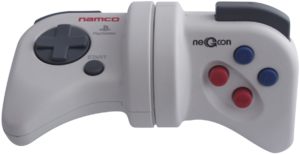Controller:NeGcon
From PCGamingWiki, the wiki about fixing PC games
This page is a stub: it lacks content and/or basic article components. You can help to expand this page
by adding an image or additional information.
 |
|
| XInput support | |
|---|---|
| Successor | |
| JoGcon | |
Key points
- The NeGcon production team based its design off various steering wheel controllers.[1]
- The controller was intended for use in racing games, including Ridge Racer, Gran Turismo and Wipeout. The NeGcon was created to replicate the analog-stick movement used in the arcade game Cyber Sled (1993); the name comes from the Japanese word "nejiru", meaning "to twist".[1]
- The twisting swivel-joint can be used to emulate analogue triggers or left/right stick.
- The I and II buttons are analogue and have approximately 7mm of travel. The L shoulder button is also analogue and has approximately 5mm of travel.
- Lacks standard layout L2, R2 or sᴇʟᴇᴄᴛ buttons.
- Requires adapter to connect to PC.
- Lacks native XInput support, requiring the use of a XInput wrapper (see Windows) for games that do not support DirectInput or the controller natively.
Inputs
- 1 × twisting swivel-joint
- 2 × digital shoulder button: R
- 2 × pressure-sensitive shoulder button: L
- 3 × digital action buttons: 𝐀, 𝐁, sᴛᴀʀᴛ
- 2 × pressure-sensitive action buttons: I, II
- 4 × digital directional buttons (d-pad): ↑, ↓, ←, →
Adapters
SmartJoy Dual Plus USB Adapter
- NeGcon analog twist function is mapped to analog X-Axis, analog I and II buttons are mapped to analog Y-Axis and analog L shoulder button is mapped to Analog Z-Axis.[2]
